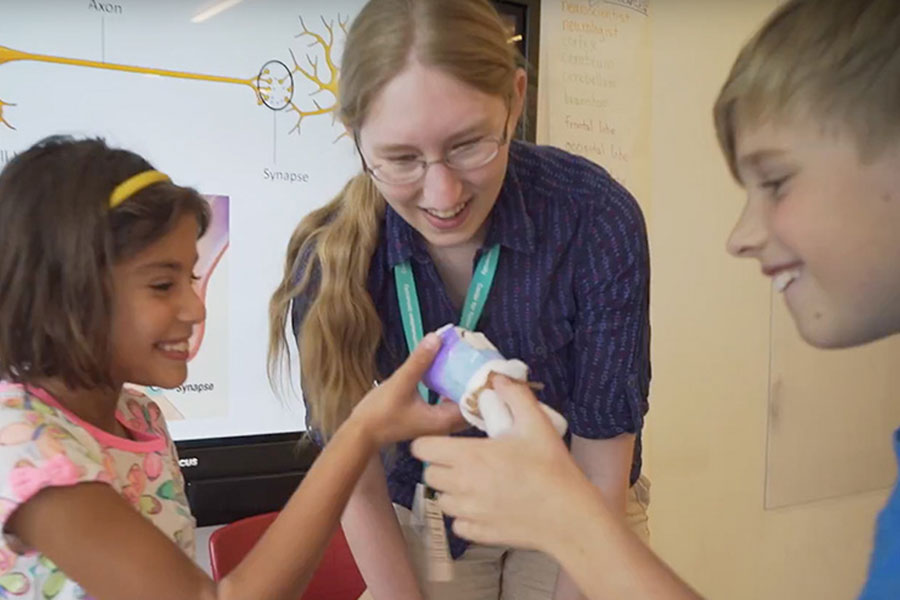10 Tips for Getting Started Online Successfully
By Eric Calvert, Associate Director
Center for Talent Development has been an innovative provider of distance and online learning for more than 30 years, growing from a single course in Latin to a program now serving students around the globe through more than 200 courses designed specifically with advanced learners in mind. Over the years, we’ve learned a great deal, and we are happy to share suggestions for those who are making the switch to full-time online instruction.
Below are 10 helpful tips.
- Use “first day of school” strategies to kick-off your return to school in an online format. Effective online teachers are explicit about settings norms for appropriate online behavior and clearly articulate expectations about student work and contributions to online discussions. A great early activity might be to re-share classroom codes of conduct and hold an online discussion about how expectations would be reflected online.
- Check in with students frequently. Online teachers have to be thoughtful about generating opportunities for students to provide feedback on their understanding and readiness to move forward. Polls asking students to rate their understanding of an assignment on a scale ranging from “I feel totally lost” to “I’m ready to go” at the end of a set of instructions can render immediate feedback. A discussion prompt asking students to post one word or one image that represents how they’re feeling at the moment can be surprisingly informative. Taking regular brief samples of student confidence and engagement will help you know when to speed up, slow down, or explain something differently to individual students and small groups.
- Establish a strong personal “presence” in your online learning environment. Students need to see models of appropriate online interaction in an academically oriented virtual space. Be sure that you have a first post in your online course space BEFORE students arrive that re-introduces you and sets the tone. Also, spend some time talking with students about their plans to create a productive workspace for themselves at home. Talking about managing potential distractions can help students stay on task and increase the likelihood of success. Share parts of your own routine that let you get focused. Once you’ve established a positive tone, continue to be a frequent visible presence in the online course space. Doing something as simple as replying to a discussion post with a thumbs up reminds students that you’re there.
- Leverage students’ interests to maintain engagement. Capitalizing on students’ intrinsic interests is crucial in an online environment. Provide as many opportunities for choice-based differentiation as you can manage to capitalize on students’ interests. Where possible, give students choices about course readings, different activities and media for learning key course concepts, and modes of sharing their ideas and work. You may also find it easier to support flexible pacing in an online environment where keeping students in sync with one another is often less critical.
- Don’t go overboard with apps. Teaching effectively online is not about using the most or trendiest apps. Remember that whenever we introduce a new app to students a part of their attention and working memory has to be devoted to figuring out the technology. Identify a single online space you will use as the “hub” for your class that you will consistently use as the jumping-off point to other sites, apps, and resources and condition your students to starting each class by going there. As you consider expanding your toolkit, give preference to tools that integrate well with online platforms that are already familiar to your students or tools that have interfaces that are similar to tools that they are already familiar with. Avoid introducing multiple new apps all at once.
- Don’t just tell. Demo. For helping students learn to use new technology tools, “showing” can be much more efficient than “telling.” Find a simple screen recording software and use it to create short demos of how to navigate and use the most essential tools for participation in your class. Many students already use sites like YouTube to acquire procedural skills not explicitly taught in schools. When recording technology demo videos, a great thing to tell students is, “First, watch me do this step. Now, you try it. Press pause now and press play again when you have completed this step. To review this step, rewind this video 30 seconds.”
- Anticipate questions and make a plan to provide answers at scale. Expect that students (and parents) will have LOTS of questions. Rather than try to reply to all inquiries individually, try to anticipate questions that students and families are likely to ask and start developing a self-serve FAQ resource for students and families to check. Consider creating a Q&A forum connected to major assignments for your class where answers to one student can inform all. When a student raises a sensitive issue in a shared forum, feel free to respond by posting a somewhat vague response in the shared forum and then connect with the student or parent individually. Be sure to point out the “help” or “support” button or link when one exists in the tools you use. It is likely that many students can find answers to technology-related questions in existing documentation.
- Remember that students learn through feedback. While we want to provide regular, individualized feedback, you and your students will encounter bottlenecks if you are the only source of useful feedback and you try to provide all feedback by responding to individual questions. While you do need to provide some individualized feedback, think about how you can provide scaffolding so that students can provide each other with useful feedback. Look for examples in individual questions and work products that can be shared (with student permission) as models and examples for feedback you provide to a group or whole class. Finally, get students actively involved in providing feedback to one another. Provide examples of what constructive critique looks like and task individual students or small groups to provide focused feedback around a specific learning goal.
- Capitalize on the power of online learning to support reflection. Students learn and retain more when they have opportunities to reflect on their own experiences and progress. In an online course, you can revisit an old conversation that relates to a new reading. You can show students how they’ve progressed and how their thinking has evolved by pointing them back to their past work. Think of the accumulation of student work and captured conversation that occurs in an online course as a self-generating portfolio. Using students’ own work to show them their progress can be powerfully motivating and build learner self-efficacy.
- Remember that students need community. For teaching any particular skill in the K-12 academic content standards, there are dozens of online resources that can be used effectively to convey academic concepts. If a Khan Academy video or Funbrain game can give a useful explanation or meaningful practice, use that. However, only humans can authentically convey care and empathy to other humans. Don’t forget that your class is more than content. Look for opportunities to remind your students that, even though you’re not with them physically, you’re there for them. Find ways to highlight the fact that their friends from class are also going through the same experience.
One final thought: As educators we try to create the best experiences possible for our students, but be forgiving of yourself and share the ways you are learning with your students. If we can be of assistance, contact us at ctd-school-services@northwestern.edu.

